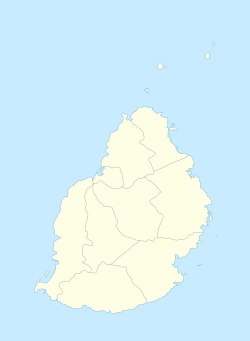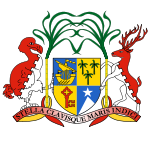Port Louis
| Port Louis | |||
|---|---|---|---|
|
|
|||
|
|||
 |
|||
 Port Louis
|
|||
| Coordinates: | |||
| Country | Mauritius | ||
| Founded | 1735 | ||
| City status | August 25, 1966 | ||
| Government | |||
| - President of Mauritius | Sir Anerood Jugnauth | ||
| - Lord Mayor | The Hon.Mahendra Gondeea | ||
| Area | |||
| - City | 42.7 km2 (16.5 sq mi) | ||
| - Urban | 6.3 km2 (2.4 sq mi) | ||
| Population (2003) | |||
| - City | 147,688 | ||
| - Density | 3,458.73/km2 (8,958.1/sq mi) | ||
| Time zone | MUT (UTC+4) | ||
| Website | mpl.intnet.mu/home.htm | ||
Port Louis (pronounced in French as IPA: [pɔʁlwi]) is the capital of Mauritius. It is the largest city of the country and main port, which borders the Indian Ocean. It is located in the Port Louis District. The population is 147,688 (2003 census).
Contents |
History
Port Louis was already in use as a harbor in 1638. In 1735, under French government, it became the administrative center of Mauritius and a major reprovisioning halt for French ships travelling around the Cape of Good Hope. The Port is named in honour of King Louis XV. The first Governor was Count Bertrand-François Mahé de La Bourdonnais.
Geography
The City of Port Louis is located at 20°10' South, 57°31'30" East (-20.1667, 57.525).[1] Its localities include Plaine Verte, Chinatown, Ward IV, Vallee Pitot, Tranquebar and city centre. Port Louis is capital of the District of Port Louis.
Sights


Port Louis has conserved many historic and colonial buildings through the years. One of them is a fortification named Fort Adelaide or La Citadelle, built by the British in 1835. The latter dominates the city. From there, one can observe most of the city's architecture. Port Louis is surrounded by a mountain range, called the Port Louis Moka Range. Among its most famous mountains are Le Pouce and Pieter Both which stand about 800 metres from sea level. One of the most popular attractions is the country's national derby called Champ de Mars, which is the oldest race course (1812) in the Indian Ocean and the second oldest in the southern Hemisphere. Other famous destinations include the Police Barracks known as Les Casernes and the Port Louis Waterfront.
The Mauritius Institute, dedicated to the study of the island's flora and fauna, is in Port Louis. Citizens often climb up the Signaux mountain, which is a 3-km track, that leads to over 300 metres high. From there, one can appreciate the landscape of the city.
Attractions include the Caudan Waterfront, Port Louis Bazaar, the Mauritian Chinatown and the old Port Louis theatre. The capital has also three museums which are: the Mauritius Natural History Museum, the Blue Penny Museum and the Mauritius Stamp Museum. The biggest and oldest post office in Mauritius is found near the Caudan Waterfront. Situated in the heart of the city, near the State Bank Tower, the Place d'Armes is easily recognizable by its tall palm trees. It is the main entrance to and out of Port Louis.
Port Louis is the busiest city of the country. It faces heavy traffic congestion as there is only one motorway which leads in and out of the city. The busiest hours are 8am and 5pm, which roughly correspond to the working hours for the majority of enterprises. Parking is another big problem the city faces. The financial centre is also located there, with the Bank of Mauritius, the Mauritius Commercial Bank Ltd and the State Bank of Mauritius, all having their headquarters there.
The busiest street is Sir Seewoosagur Ramgoolam Street, formerly known as Rue Desforges. It leads directly to the Municipality of Port Louis, the Jummah Mosque, and Kadafi Square, which is a hot place for local food. Ornately and colourfully decorated Tamil temples such as the Kaliammen Kovil and the Tamil temple of Saint-Croix overlook the port.
There is a Jewish cemetery at Saint–Martin from the period (1941–1945) when the British interned captured immigrants to Mandate Palestine in a detention camp at Rose Hill[2]. There is also a Chinese Burial ground where elaborate memorials have been erected. The city morgue at the Kit Lock is located in the centre of the city.
The skyline of Port Louis has completely changed in the last fifteen years mainly due to construction booms in the 1990s and 2000s, where many of the tallest high-rise buildings have been built. The city centre has the tallest buildings in Mauritius, including a few skyscrapers, which is unusual for a small island in Africa. Port Louis is currently undergoing a major construction boom with the extension of the Caudan Waterfront and new towers.
Port Louis also harbours some major schools. The Royal College of Port Louis and the Loreto College of Port Louis forms part of the Star Colleges of Mauritius. Bell-village SSS, and Port-Louis SSS, and Renganaden Seeneevasen are also colleges with positive academic achievement.
Horse racing
The Champ de Mars Racecourse is a race track for Thoroughbred horse races located close to the centre of Port Louis founded in 1812.
Economy
The economy is dominated by its port, which handles Mauritius' international trade. The port was founded by the French who preferred Port Louis as the City is shielded by the Port Louis/Moka mountain range. It is the largest container handling facility in the Indian Ocean and can accommodate fourth and fifth generation container vessels. At present, only Cape Town and Port Louis can achieve that in Sub-Saharan Africa.[3] However, existing equipments in the port are overstretched and delays frequently occur. Two new gantry cranes (to be delivered in December 2007) will boost annual throughput capacity. Manufacturing is dominated by clothing and textiles, but also includes chemicals, plastics, and pharmaceuticals. Tourism is also important. The development of the Caudan Waterfront, central to Port Louis, with shopping and cinema facilities, appeals to tourists visiting the city. Port Louis is the second most important financial center in Africa after Johannesburg. It is the city with the highest per capita income in Africa.
Air transportation to the city is provided by Sir Seewoosagur Ramgoolam International Airport.
Demographics
The population of the city is now largely made up of the descendants of laborers who were hired for labor from India in the 19th century. Slaves were previously introduced by the British and French who colonized the island in the 18th century. After the abolition of slavery in 1835, many Indian and Chinese workers were brought to work the land, and cultivate sugar cane, at that time used to produce rum. The Immigration Depot in Port Louis is a World Heritage Site commemorating this great migration.
Currently, the majority of the population, more than 75 percent, are Indians of mixed origins (a significant percentage being followers of the Hindu and Muslim faith), with the rest from Africa and a minority of Chinese and Eurasian.
Culture
Port Louis has attracted various artists and writers in the past, among the most renowned of them are Bernardin de Saint Pierre, Mark Twain, Nicolas Pike, Charles Baudelaire, and Paul-Jean Toulet.
Mauritian writers like Malcolm de Chazal, Marcel Cabon, Félix Laventure, Loys Masson and Marie-Thérèse Humbert chose Port Louis and its vicinities as locations for some of their novels and poetry.
Other Port Louis born poets and writers, like Robert Edward Hart and Khal Torabully, also made of this intricate and fascinating town the setting of some of their texts.
Gallery
|
The city in the mid-1980s. |
Buildings at Port Louis. |
The city of Port Louis. |
 Port Louis' banking district, and the main avenue leading to the Government House (seen in the background). |
|
View of Port Louis and harbour looking west from the Citadel. |
Panorama

Climate
Port Louis features a tropical wet and dry climate with a lengthy wet season and a short dry season. Its wettest months are from December through April where on average 100mm (or more) of rain falls during each of these month. The months of September through November forms the dry season, though technically July, with an average of just under 60 mm of precipitation, could be considered a dry season month. The city also shows a noticeable range of average temperatures. Port Louis’ coolest temperatures are seen mid-year where average high temperatures are around 24°C. During the height of the wet season, the city sees its highest temperatures where average high temperatures are usually around 30°C.
| Climate data for Port Louis | |||||||||||||
|---|---|---|---|---|---|---|---|---|---|---|---|---|---|
| Month | Jan | Feb | Mar | Apr | May | Jun | Jul | Aug | Sep | Oct | Nov | Dec | Year |
| Source: BBC Weather [4] | |||||||||||||
Transport
Between 1860s and 1960s, the island had a railway system centred on Port Louis. In 2009, due to growing road traffic congestion, consideration is being given to introducing a metro system.
See also
- Railway stations in Mauritius (The railways system was designed mainly for the transportation of goods, mainly sugar, from different part of the country to the city.)
Sister cities

 Saint-Malo, since 1999.
Saint-Malo, since 1999.
References
- ↑ National Geospacial-Intelligence Agency. "GNS: Country Files". GNS Country Files. http://earth-info.nga.mil/gns/html/cntry_files.html. Retrieved 2007-04-08.
- ↑ Ghetto Fighters' House archives
- ↑ Port Strategy. "Feeder king". portstrategy.com. http://www.portstrategy.com/archive/2007/march/area_survey_africa__and__indian_ocean_islands/feeder_king. Retrieved 2007-10-14.
- ↑ "Average Conditions Port Louis, Mauritius". BBC Weather. http://www.bbc.co.uk/weather/world/city_guides/results.shtml?tt=TT004830. Retrieved August 17, 2009.
- Malcolm de Chazal, Petrusmok, The Standard Printing Est., 1951, La Table Ovale, 1979.
- Marie-Thérèse Humbert , La montagne des signaux, Paris : Stock, 1994
- Khal Torabully, Kot sa parol la - Rôde parole, poésie en créole et français, éditions Le Printemps, 1996, Maurice.
External links
|
||||||||||||||||||||||||||||||||||||||||||||||

